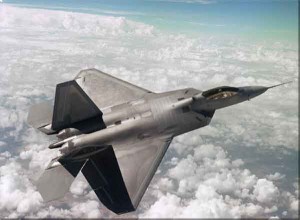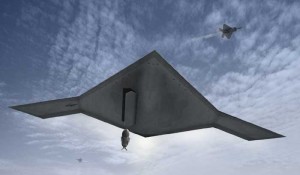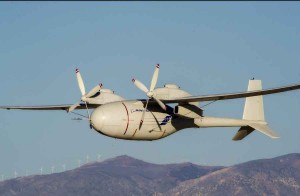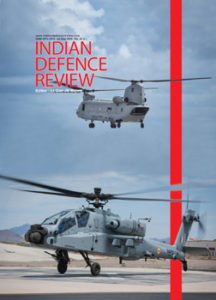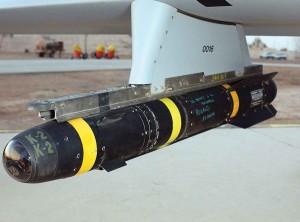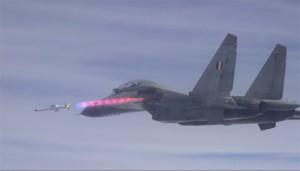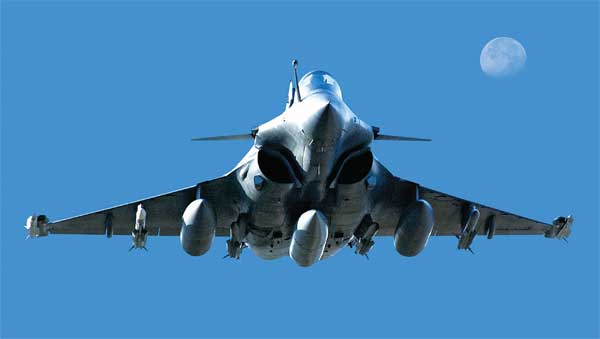
The USAF and the US Navy are leading the evolution of next-generation platforms and technologies. Defence Advanced Research Projects Agency, USAF Research Labs, Boeing ‘Phantom Works’, Lockheed Martin’s ‘Skunk Works’ and NASA are all aiding the work on concepts of ‘Air Dominance’ for 2040 and beyond. US, China and Russia are working on the sixth-generation fighters which will be inducted from 2028 onwards. The Fighter Bomber as a platform, therefore, is still here to stay. More and more of these will become uninhabited or optionally manned. There will be dramatic changes in the aerial platform performance and aerial weapons. The line defining Atmosphere and Space will get smudged. Aerospace will soon become a common domain with more aerospace-craft routinely transiting, taking advantage of each.
The weapon delivering air platforms are becoming faster and more efficient for deeper penetration…
In its quest to dominate the air battlefield of the future, the United States Air Force (USAF) may look to replace the traditional fighter jet with a network of integrated systems disaggregated across multiple platforms. A rapidly evolving global defence landscape is prompting the way the US and its allies develop technology to deter current and emerging threats and to produce the non-linear, game-changing combat capabilities required for national security. It could be a “family of systems” to address the range of threats in a highly contested environment. As Russia and China continue to close the capability gap with the US by building long-range missiles, anti-satellite and anti-aircraft weapons to foil the ability of the US forces to penetrate, the USAF is looking at new ways to dominate the air.
The new strategy will include both stand-off capability and penetrating forces, with increased dependence on space and cyber to infiltrate enemy defences and defend own networks. The USAF has allotted funds in its 2017 budget for experimentation and prototyping in the area of air superiority. These funds are meant to explore concepts like the arsenal plane, hypersonic weapons, directed energy weapons, autonomy and electronic attack. The effort, called “Next Generation Air Dominance,” is planned to be complete by mid- 2018. The USAF will work to find the most effective combination of speed and maneuverability, payload and range for the platform. The right level of stealth or low observability will also be considered.
The USAF and the US Navy (USN) are leading the evolution of next-generation platforms and technologies. Defence Advanced Research Projects Agency (DARPA), USAF Research Labs (AFRL), Boeing ‘Phantom Works’, Lockheed Martin’s ‘Skunk Works’ and NASA are all aiding the work on concepts of ‘Air Dominance’ for 2040 and beyond. US, China and Russia are working on the Sixth-Generation fighters which will be inducted from 2028 onwards. The Fighter Bomber as a platform, therefore, is still here to stay. More and more of these will become uninhabited or optionally manned. There will be dramatic changes in the aerial platform performance and aerial weapons. The line defining Atmosphere and Space will get smudged. Aerospace will soon become a common domain with more aerospace-craft routinely transiting, taking advantage of each. Combat engagements will be at much higher speeds and much greater distances.
One who controls Space will control the Air in future. Aerospace craft will aim to seize control establishing dominance/supremacy over the enemy’s aerospace assets. They will operate under the control/co-ordination of space-based Early Warning and Control satellites with increased Artificial intelligence (AI). Satellite/aircraft-based kinetic and Directed Energy Weapons (DEW) will soon be a reality and will be used for aerial or surface attack. Even if aerospace supremacy cannot be established, a ‘degree of dominance’ in the air space bubble in a given area and given time-space without prohibitive interference by opposing air forces, will be desired.
Expanding Air Threats
The world already has eight overt nuclear powers, one covert nuclear power (Israel) and at least two nuclear aspirants (Saudi Arabia and Iran). The Nuclear Non-Proliferation Treaty (NPT) is still not fully effective. More and more countries are acquiring missile technology. Missiles are becoming faster, more accurate, have longer range and larger multiple warheads. The weapon delivering air platforms are becoming faster and more efficient for deeper penetration. Airborne radars and missiles have much greater ranges. AI will find more optimum and timely combat solutions. The non-state actors and rogue regimes which follow no international norms and ethics, are trying to acquire weapons of mass destruction. They could be a threat difficult to define. Any future air platforms would have to factor in all this.
Uninhabited aircraft technologies are already proven and the future is Uninhabited Aerial Systems (UAS)…
The Basic Concepts and Approach
Concepts from the USAF and industry have so far revolved around supersonic tail-less aircraft. American sixth-generation fighters are to feature AI as a decision aid to the pilot, similar in concept to how advanced sensor fusion was used by the F-22 and F-35. They will also have Positioning, Navigation and Timing (PNT) and communications that allow big data movement between the inter-service’s aircraft. Unlike the previous F-22 and F-35 development programmes that depended on new technologies that drove up cost and delayed introduction, the USAF is keen to follow a path of risk reduction by prototyping, technology demonstration and systems engineering work as possible before creation of an aircraft actually starts. It will not just be an aircraft, but a system of systems including communications, space capabilities, stand-off and stand-in options. The two-service common design and technology efforts including engine, airframe moulds, broadband, IR stealth and new ways to dominate the electromagnetic spectrum.
Another study has concluded that the next-generation USAF fighter should be larger and resembling a bomber than a small, maneuverable traditional fighter. It analysed over 1,450 air-to-air engagements since 1965 and found that long-range weapons and sensors have dramatically decreased instances of dog-fighting. With the increase of air defence systems using electronic and infrared sensors and high-speed weapons, traditional designs relying on small size, high speed and maneuverability, maybe less relevant and easier to intercept. As a result, what is suggested is building a fighter significantly larger relying on enhanced sensors, signature control, networked situational awareness and very-long-range weapons to complete engagements before being detected or tracked.
Larger planes would have greater range that would enable them to be stationed further from a combat zone, have greater radar and IR detection capabilities and carry bigger and longer-range missiles. The USAF Scientific Advisory Board has suggested a Penetrating Counter Air (PCA) platform that would combine long range, supersonic speed, stealth and maneuverability. PCA would have substantially longer range to fly long distances over the Pacific, especially in a situation where airbases in the vicinity of China are not available. It would also escort bombers deep into Russia or China, where the anticipated threat includes advanced networked air defence radars. It would include stealth against low or very high frequency radars which require an airframe with no vertical stabilisers. Another requirement is significantly larger payload than that of current air superiority aircraft like the F-22.
Uninhabited Aerial Systems
Uninhabited aircraft technologies are already proven and the future is Uninhabited Aerial Systems (UAS). The world is in transition. There are some who see the F-35 as the last manned fighter/bomber. Solar-powered UAS are already flying. Currently, the solar-powered Zephyr holds the endurance record for UAVs with 14 days in the air. Dual use (optionally manned) aircraft are also flying. The USAF has already modified F-4s and F-16s to fly them remotely. In France, Dassault leads a multi-nation delta wing UCAV ‘Neuron’ of the size of Mirage 2000.
UK has a Strategic UAS programme ‘Taranis’. UAS are taking-off and landing by themselves including on the moving aircraft carrier (Northrop Grumman X-47B). Autonomous air refueling has been tested. Lockheed Martin’s UCLASS drone ‘Sea Ghost’ looks rather like a stealth bomber and is expected to carry 1,000-lbs class weapons. USA is also working on Hypersonic (Mach 6) Strike Bomber likely to be optionally manned. Uninhabited helicopter convoys will deliver supplies to troops deployed on combat front lines. The US Army’s dramatic shift to a nearly all-unmanned flight over the next three decades is embedded in the UAS roadmap. The USAF’s UAS vision document indicates that by year 2047, every mission would be unmanned.
China’s quick aerospace advancement pace is driving the USAF to react…
Lockheed Martin’s Skunk Works
The Lockheed Skunk Works’ innovation and development of leading edge technology has churned out world beater aircraft like the F-16, SR-71, F-117, F-22 and F-35 and more in the last 70 years. Lockheed Martin has been working alongside DARPA, Air Force and Navy to determine viable approaches to maintain US air dominance capabilities in the post-2035 world. They are exploring new technical capabilities and options for the development of future Next Generation Air Dominance (NGAD) air platforms, as well as potential enhancements to current platforms.
Boeing Phantom Works
Phantom Works is the advanced prototyping arm of the defence and security side of the Boeing Company. Its primary focus is developing advanced military products and technologies, many of them highly classified. Founded by McDonnell Douglas, it continued after Boeing acquired the company. Its logo is similar to one used for the McDonnell Douglas F-4 Phantom fighter.
Phantom Works’ responsibility is to grow those technologies into prototype to then transition those prototypes to the business units to turn into products. Headquartered in Washington DC, Phantom Works has projects in most Boeing locations in the US. Additionally, an international group does modeling and simulation work for various countries including Britain, Australia and India.
Next-Generation American Fighter
The USAF is pursuing development and acquisition of a sixth-generation fighter through the F-X programme to replace its existing aircraft such as the McDonnell Douglas F-15 Eagle and complement existing platforms in service such as the Lockheed Martin F-22 Raptor. The USN is pursuing a similar programme called the Next-Generation Air Dominance intended to complement the smaller Lockheed F-35 and replace its existing aircraft such as the Boeing F/A-18E/F Super Hornet. In April 2013, DARPA initiated a study to try to bridge the USAF and USN concepts. Next-generation fighter efforts will initially be led by DARPA under the ‘Air Dominance Initiative’ to develop prototype X-planes. The USAF and USN will each have variants focused on their mission requirements.
The combat pilot still has backers and still has a place onboard…
In 2016, the USAF announced a change of course to pursue “a network of integrated systems disaggregated across multiple platforms” rather than a ‘sixth-generation fighter’ in its Air Superiority 2030 plan. Dubbed the “Next-Generation Tactical Aircraft (Next-Gen TACAIR)”, the USAF seeks a fighter with “enhanced capabilities in areas such as reach, persistence, survivability, net-centricity, situational awareness, human-system integration and weapons effects”. The future system will have to counter adversaries equipped with next-generation advanced electronic attack, sophisticated integrated air defence systems, passive detection, integrated self-protection, DEW and cyber attack capabilities. It must be able to operate in the anti-access/area-denial environment that will exist in the 2030–2050 timeframe.
The USAF’s new budget request for Fiscal 2019 shows, the service asked for $504 million next year for its Next-Generation Air Dominance research, development, test and evaluation programme. In the next five years of planned spending, the USAF desires to invest roughly $11 billion on Next-Gen Air Dominance. China’s quick aerospace advancement pace is driving the USAF to react. There has been explicit recognition “of the re-emergence of great power competition”. Similarly, the USN has a much higher priority on range and speed. AI and optionally manned are becoming critical requirements generally. There is a need for survivability. Stealth is just one piece of the survivability equation, others such as ultra-lightweight armour and counter-directed energy capabilities are required. The USN acknowledges that the service will need to keep costs low enough to buy a large number of air vehicles as numbers matter.
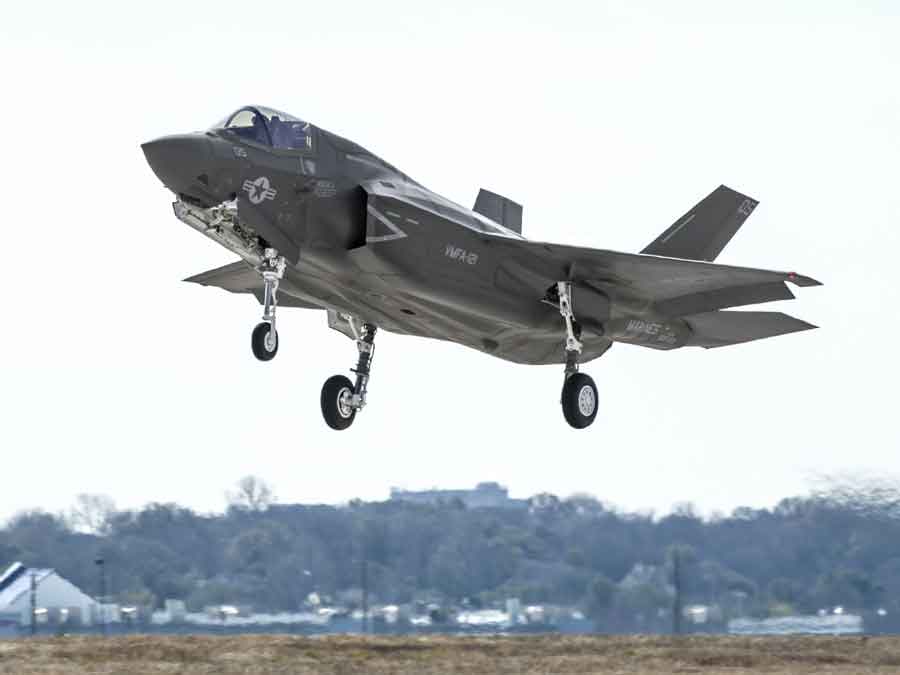
Lockheed Martin’s F-35B
Sixth-Generation Fighters
Boeing is proposing a replacement for the F-22A Raptor. The project is currently in concept stage and the USAF remains non-committal. Boeing envisages the F/A-XX, F-X and a possible Unmanned Combat Air Vehicle (UCAV) comprising an all-encompassing future strategy. Boeing is also responding to the USN’s request for information regarding a new F/A-XX aircraft that could replace its fleet of Super Hornets in the 2030s. The regular Hornet aircraft is being replaced by the F-35s. Lockheed Martin’s proposal calls for greater speed, range, stealth and self-healing structures; developments that will require new breakthroughs in propulsion, materials, power generation and weapon technology. Self-healing structures in particular would have significant advantage over modern-day aircraft, remaining airborne despite taking heavy fire.
A laser weapon is expected to be mounted on Next-Generation Air Dominance fighters by the 2030s…
The system comprises pockets of epoxy resin and hardener installed around vulnerable parts of the aircraft such as the underbelly, hatchways and wheel wells. If the area is damaged, the contents of the pocket are released to form a temporary plug, helping the aircraft to operate despite the damage. New generation of engines will allow ultra-high altitude super-cruise. The avionics are supposed to withstand next generation electronic attack and cyber-attack, have passive detection and integrated self-protection. The tailless flying wing, “cranked kite” design concept currently appears the way forward for future fighter aircraft. The sixth-generation fighters are expected to use advanced engines such as ‘Adaptive Versatile Engine’ technology to allow longer ranges and higher performance, where the ratios of bypass and compression airflow can be made variable to improve efficiency. Major action is unfolding. The combat pilot still has backers and still has a place onboard.
New Engine Technology
The sixth-generation fighters are expected to use advanced engines such as Adaptive Versatile Engine Technology to allow longer range and higher performance. The engines are expected to be ready when fighters are introduced by the USN in 2028 and the USAF in 2032. The laser and systems controls are to work at altitudes from sea level to 65,000 ft at speeds from Mach 0.6 to Mach 2.5. The newer engines could vary their bypass ratios for optimum efficiency at any speed or altitude. That would give an aircraft a much greater range, faster acceleration and greater subsonic cruise efficiency. A variable cycle engine could configure itself to act like a turbojet at supersonic speeds while performing like a high-bypass turbofan for efficient cruising at slower speeds; the ability to super-cruise may not be a critical requirement. A low-bypass configuration would be used for takeoffs and supersonic flight and a high-bypass configuration would have high propulsive efficiency for cruising. Companies involved with next-generation engine development include General Electric and Pratt & Whitney.
Evolving Future Weaponry
Future weaponry would utilise scramjets for the production of faster missiles. Despite failing its recent tests, Boeing’s X-51A Wave-rider scramjet remains in development as it hopes to reach hypersonic speeds approaching Mach 6, a speed at which a missile could not be stopped by conventional air defence technology. Continued experiments with DEW and lasers, used for defensive as well as offensive measures, delivering effects at the speed of light, are also likely to shape precisely what sixth-generation fighters are equipped with. New aircraft will be as much about reusable weaponry (lasers) as it is about expendable weaponry.
The USAF is interested in three categories of lasers – low-power for illuminating, tracking, targeting and defeating enemy sensors; moderate-power for protection to destroy incoming missiles and high-power to offensively engage enemy aircraft and ground targets. The USAF is developing a new air-to-air missile, dubbed the Small Advanced Capabilities Missile (SACM) for 2030s. The SACM would promise an improved solid rocket motor having synergised control enabled by combined aero, attitude control and thrust vectoring. The missile will have improved ‘high off bore sight’ for rear hemisphere kills and ‘lower cost per kill’. The missile would also incorporate energy optimising guidance, navigation and control. The Miniature Self-Defence Munitions (MSDM) will enhance future platforms self-defence capability without impacting the primary weapon payload.
The USAF is developing a new air-to-air missile, dubbed the Small Advanced Capabilities Missile (SACM) for 2030s…
A sixth-generation missile could replace the AMRAAM. A survivable, long-range missile with combined air-to-air and air-to-ground capabilities is being evolved. Range would be a big factor to counter potential adversaries with Chinese PL-15. It will be multi-band, broad spectrum which aids it in survivability and reaching the target. DARPA’s Triple Target Terminator (T3) programme envisions combined capabilities of Raytheon’s AIM-120 and AGM-88 High-speed Anti-Radiation Missile (HARM). No aircraft is invisible and using stand-off weaponry early in an air campaign to open up weaknesses in an enemy’s air defence will be required even for fifth-generation fighter aircraft to operate in the area without excess risk.
Development of solid-state airborne laser capability is already underway. The solid-state laser systems defensively create a sanitised sphere of safety around the aircraft, shooting down or critically damaging incoming missiles and approaching aircraft with the laser turrets. Even attacking targets on the ground such as individual people with pinpoint precision or shooting down ballistic missiles and other traditional targets are possibilities. Controlling the aircraft’s heat signature while using laser weaponry will be an issue. One option is to develop a thermal accumulator or alternatively, off-board venting to manage the heat. Newer liquid-based lasers promise enough energy to bring down an aircraft (about 150kW) yet are small enough to fit on a truck or be mounted on a jet fighter. A laser weapon is expected to be mounted on Next-Generation Air Dominance fighters by the 2030s.
Evolving Other Technologies
For long, military aviation doctrines and requirements drove technology. Today, technologies are offering enhanced capabilities that are driving operational employment and tactics. AI, smart structures and hybrid systems will dictate the future. Demand for streaming high-quality data requires bandwidth which involves innovating sensor/processing systems. Mission computer systems and network-centric payload processing units enable onboard data fusion prior to sending to digital links. Thermally efficient, high-performance computing onboard the aircraft is essential. Next-generation avionics would be smaller, more efficient and capable of operating under extreme conditions. Gallium Nitride (GaN) is a semi-conductor material that is more efficient, easier to cool and improves reliability for radars. Any system must be designed with aim for maintaining a competitive advantage in an austere budget environment.
As on date, the AMCA is still at project definition stage and the first flight could be around 2028 with induction in 2035…
The Passive Aero-elastic Tailored (PAT), a uniquely designed composite wing will be lighter, more structurally efficient and have flexibility compared to conventional wings. This wing will maximise structural efficiency, reduce weight and conserve fuel. Hypersonic cruise, fuel cell technologies, hybrid sensors, improved human-machine interface using data analytics and bio-mimicry, combination of materials, apertures and radio frequencies that ensure survival in enemy territory are under development. Things will be built faster, better and more affordably, using 3D printing yet ensuring quality and safety standards. Additive 3D manufacture creates a world with spare parts on demand, faster maintenance and repairs, more effective electronics and customised weapons. The development of a hypersonic aircraft would forever change the ability to respond to conflict. Nano-materials will control sizes, shapes and compositions and significantly reduce weight yet create stronger structures for air and spacecraft, yet drive down costs.
Need for Heavy Stealth
Fighters such as the F-35 and F-22 may be stealthy, but their support assets such as aerial tankers, JSTAR and AWACS are not. The USAF needs ‘heavy stealth revolution’ for low observable tankers, transports, bombers and ‘flying sensor and communications trucks’, as these will be targeted. The USAF could adapt the new stealth bomber design for the stealth tanker role. It will also give ability to insert special operations teams deep behind enemy lines via a stealthy high-altitude penetrating transport.
Japan’s sixth-generation fighter would be based on concept of aircraft informed, intelligent and instantaneous. Japan has already conducted the first flight of the Mitsubishi X-2 Shinshin test-bed aircraft for this project. Russia says the aircraft will most likely be pilotless. For now the FGFA Sukhoi Su-57 is being inducted. The Mikoyan MiG-41 is a sixth-generation jet fighter interceptor aircraft currently being developed for the Russian Air Force. France and Germany announced they would jointly develop a new combat aircraft to replace the Eurofighter, Tornado and Rafale. It is likely to be a twin-seat ‘system of systems’ aircraft acting as a combat platform as well as controlling the UCAVs.
France has abandoned any attempt to develop an indigenous fifth-generation fighter and has moved resources directly to development of a sixth-generation fighter aircraft. The UK is committed to a next-generation fighter programme to replace the Eurofighter Typhoon post-2030. However, the Eurofighter Typhoon has had its service life extended to around 2040. China is still evolving its J-20 and J-31. Some Chinese publications are talking of a sixth-generation aircraft referred to as Huolong (Fire Dragon). But as on date, China has serious limitations on radar, avionics and engine technologies.
The IAF today has fourth-generation plus fighters in its fleet of upgraded Jaguar, Mirage 2000, MiG-29 and SU-30 MKI…
The IAF today has fourth-generation plus fighters in its fleet of upgraded Jaguar, Mirage 2000, MiG-29 and SU-30 MKI. Other than Mirage 2000, all are twin-engine. The soon-to-induct Rafale is of fourth-generation ++ class. In the not-so-far future, the LCA Tejas will be the only single-engine aircraft. The IAF needs more fourth-generation ++ aircraft. The LCA Tejas production is slow and the planned 123 aircraft could take at least ten years to induct. The Sukhoi/HAL Fifth Generation Fighter Aircraft (FGFA) or Perspective Multi-role Fighter (PMF), a fifth-generation fighter has run serious developmental and cost road-blocks and has been abandoned. The HAL Advanced Medium Combat Aircraft (AMCA) is an Indian programme of a fifth-generation fighter aircraft. It is a single-seat, twin-engine, stealth super-maneuverable all-weather, multi-role fighter aircraft.
Lessons learnt from the LCA programme need to be imbibed and used to get the AMCA become a huge success to propel India into the new league. As on date the AMCA is still at project definition stage and the first flight could be in 2028 with induction around 2035. With fast depleting squadrons, the IAF will require 500 fighter aircraft of fourth-generation ++ aircraft. A good mix could be around 200 LCA Tejas Mk 1A, 125 twin-engine MMRCA class, ideally already selected Rafale. The remaining nearly 175 aircraft should be single-engine MMRCA class, much cheaper than the Rafale. It is time to act and think ahead lest India gets left behind once again.




